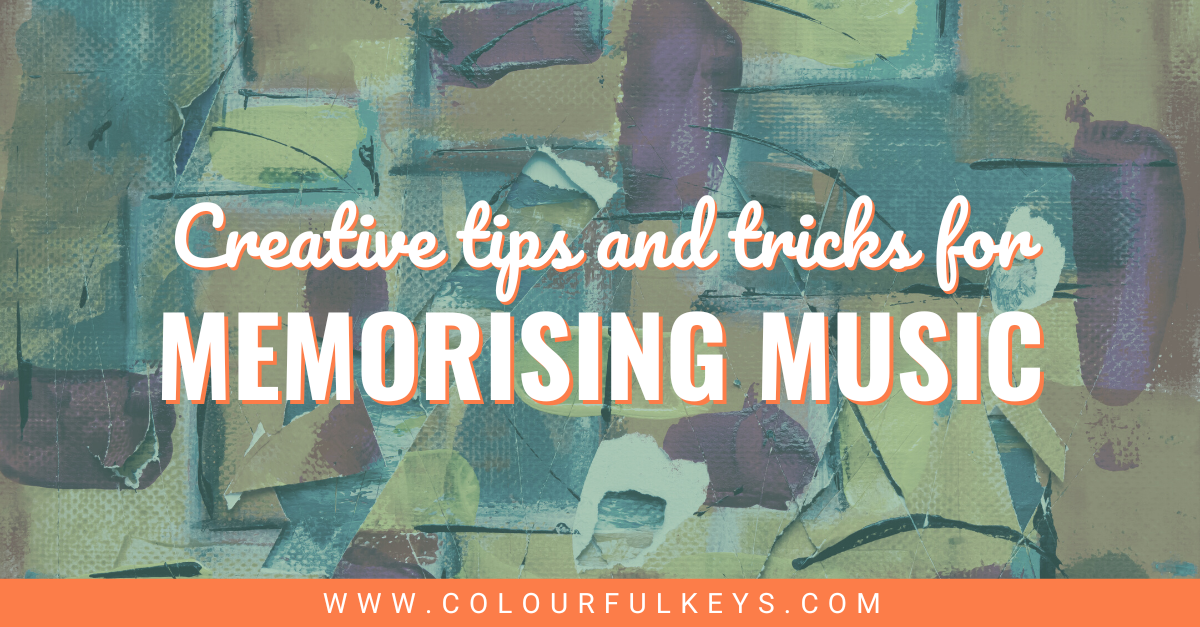
This article with creative tips and activities that promote memorisation was written by Rachel Palm. Rachel loves words and music. She teaches piano in Greenville, South Carolina. When she isn’t teaching, you can find her hiking, drinking tea, reading a massive book or playing her beloved piano. She writes about piano teaching at palmpianostudio.wordpress.com.
I’ve had jitters at piano recitals for as long as I can remember. As a teacher, the anxiety has multiplied tenfold. I fret about every note, tricky rhythm and tiny articulation as my student approaches the piano.
Did I prepare them well enough? Will they hate piano after this?

One month before a particularly stressful spring recital, I was scrolling through Facebook when I stumbled upon a video of a seven-year-old.
The student played confidently for a full minute and a half with no music. He smiled after his performance, and his teacher smiled too, looking relaxed and distinctly non-jittery.
Her name was Marilyn Lowe.
Musical Conversation = Easier Memorisation
I wanted to have students perform like this seven year old had looked: relaxed, excited and prepared. But I felt like I didn’t have a process to encourage that.
Typically it felt like moving mountains to get students to memorise and perform with confidence.
This is where Marilyn Lowe’s work helped me.
Her piano method ‘Music Moves for Piano’ is based around the idea that making music is like learning a language. Students are encouraged to develop tonal and rhythmic vocabularies and to improvise at every lesson.
Improvising or doing other creative activities with pieces is a lot like conversing using music.
The more students are able to have a back-and-forth “conversation” with their pieces, the more confident they become with their repertoire, and the easier it is for them to memorise.
Creative Activities to Support Memorisation
After exploring the ‘Music Moves’ method, I started to take this improvising idea really seriously. At every lesson, I encouraged my students to play around and “converse” with their pieces, with the ultimate goal of having a more intimate relationship with the music.
Here are 3 creative activities I have my students do along with tips to gain that familiarity with their pieces, all of which promote music memorisation.
Make It Your Own
Once a student has learnt a piece, I say, “Now I want to hear your version. Let’s change a few things.”
This has become extremely popular in my studio, to the point that students have begun telling me what they want to alter before the piece is even mastered.
Revisions can be simple, such as:
- Moving the octave
- Varying the dynamics
- Adding a repetition
- Putting in a glissando
But changes can also be more complex, such as:
- Modifying from major to minor (or vice versa)
- Changing the metre
- Adding a special introduction or ending
Create a Medley
Once two pieces have been mastered, I play them back-to-back for students. I ask them to identify similarities or differences in metre, tempo, dynamics, articulation and tonality.

They practise the pieces back to back, sometimes making changes to give them a different – or more similar – sound.
This method leads beautifully into beginning sonatinas because students have had the experience of structuring an AB or ABA piece themselves.
Joining two pieces together is also a great way to help those students who are less comfortable with original composition.
Every student I’ve had enjoys the process of combining two pieces and giving the final result a new title.
Mash It Up
Mashups can be constructed once a student has learnt several pieces (minimum of two).
Here’s what I help my student do to make a mashup of two pieces:
- Mark their favourite part of the first piece with a star
- Pick a second piece and note their most-liked part in it
- Practise those parts
- Brainstorm ways to put them together
There are lots of ways you can construct a mashup with your student, but they all start with examining various elements of the pieces.
- Octave: Should they change where the two phrases are played?
- Tonality: Are the sections major, minor or something else?
- Metre: Are they duple, triple, or quadruple?
- Dynamics: Is one of them loud while the other is softer?
- Articulations: Does one use staccato and the other legato?
Sometimes students will change the sections to be more similar to each other. Oftentimes, though, they’ll embrace the differences and create a mashup that’s full of contrast.
Need to expand your students’ perception of a piece? ‘Creative Candies’ from the Vibrant Music Teaching Library might be just the trick. Enter your info below and Nicola will send a copy directly to your inbox.

Subscribe to the newsletter and get the Creative Candies
Enter your details to subscribe to the newsletter for piano teachers with information, tips and offers.
I hate spam as much as you do! I will only send you emails related directly to piano teaching and you can unsubscribe at any time.
Not a member of VMT? Still on the fence? Take a 5-minute video tour of the membership at vibrantmusicteaching.com to see what you’re missing.
This experience of combining two or more separate pieces has helped my students become more consistent in their memorisation.
They’re far more likely to remember a piece after working with it in this creative way.
Improvisation = Spontaneous Memorisation
The tips and creative exercises I had included in each lesson bore incredible fruit: enhanced musicality and natural music memorisation.
Recital Readiness
Two terms after starting these creative activities, it was time for the spring recital.
In the weeks leading up to it, most of my students told me their recital pieces were too short. So they got busy reimagining their performance pieces.
Medleys abounded. Students wanted to make mashups with crazy titles.
Many of them didn’t even need music because they had learnt their pieces so thoroughly, and they remembered all of the alterations they had made.
Rather than having to push and pull and prod to get everyone prepared, I truly felt that I was working with young colleagues to create polished performances.
It was a fantastic recital. Everyone was having fun performing, and I felt so excited. 🙌
Confidence Through Creativity
The greatest moment of that recital was when one of my teenage students – who is often very shy – performed.
The creative activities had given her a language for what she liked and felt comfortable playing. She created a dark and dramatic solo and played it entirely from memory, moving all over the keyboard with ease.
When she finished, she was smiling. And so was I.
You can find more creative activities and get help introducing them in your studio at the Colourful Keys hub page, ‘Teaching Creative Music Skills’.

What are your favourite creative tips for fostering music memorisation?
Share your ideas in the comments below. 🙂